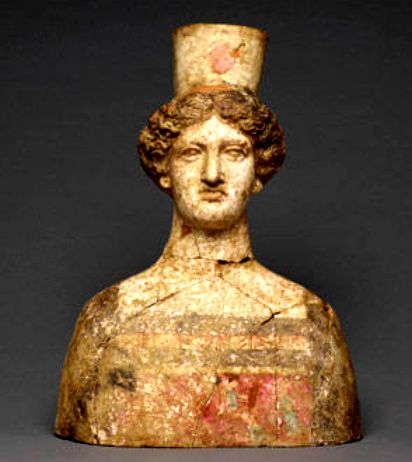A selection of 37 objects excavated from the sanctuaries of the ancient city of Morgantina in central Sicily will go on display at the Getty Villa in the exhibition The Sanctuaries of Demeter and Persephone at Morgantina. On loan from the Museo Archeologico Regionale of Aidone until January 21, 2013, these works include terracotta figures of deities, vases and oil lamps, a lead curse tablet, and bone clothing and hair pins, and are installed in a gallery devoted to images of gods and goddesses (Gallery 104).

All discovered in the sanctuaries of Morgantina and dating from the 4th to the 2nd centuries B.C., these objects demonstrate the wide range of items that were considered appropriate dedications to the gods—from simple undecorated clay lamps used in nocturnal rituals, to brightly painted (and originally bejeweled) terracotta busts depicting Persephone herself. Even modest personal ornaments such as hair pins were part of the practice of visiting a sanctuary and making an offering to the deity worshipped there. Some dedications served a less spiritual impulse. One individual deposited an inscribed lead curse tablet that calls upon the gods of the Underworld to send a slave named Venusta to the realm of the dead—in other words, for her to go to hell.
Morgantina is located in the fertile hills of central Sicily, near present-day Aidone. The remains of the ancient town have been under excavation by American and Italian archaeologists continuously since 1955. Visible there today are its sanctuaries, theater, public baths, houses, market, and granaries, which are among the best-preserved on the island. A wealth of finds, outstanding both in artistic quality and historical importance, has been unearthed from the town and surrounding cemeteries. As the site of a native Sikel village in the prehistoric period and of a later Greek settlement founded about 550 B.C., Morgantina witnesses how indigenous and colonial communities were integrated, and the role that religion can play in a multicultural society.

“We are thrilled to have these unique objects from Morgantina—an excavation where generations of American archaeologists were trained—on view for the first time in the United States at the Getty Museum,” says Claire Lyons, acting senior curator of Antiquities at the J. Paul Getty Museum. “These loans represent the great benefits of collaboration, and help to share and preserve Sicily’s rich cultural heritage for future generations.”
“With this special exhibition, we are very excited to launch a new era of close collaboration between the Museum of Aidone, today part of the Archaeological Park of Morgantina, an ancillary institute of the Sicilian Ministry of Culture and Sicilian Identity, and the J. Paul Getty Museum,” remarked Enrico Caruso, Director of the Parco Archeologico di Morgantina. “Thanks to this initiative, our reciprocal relationship will emerge strengthened and will be continually renewed in future projects, for fruitful academic and especially cultural exchanges.”

Previous loans include the Gela Krater, a monumental red-figure volute-krater (wine mixing vessel) attributed to the Niobid Painter, and The Agrigento Youth, a rare example of an early classical marble statue called a kouros, both of which are among the masterpieces of the Museo Archeologico Regionale of Agrigento.
Also part of the 2010 agreement, the Getty Museum will present the exhibition Sicily: Between Greece and Rome in spring 2013. Exploring innovations in the art, literature, and science of ancient Sicily between the 5th and 3rd centuries B.C., this exhibition will bring some sixty important loans to Los Angeles.
The Villa has hosted other high-profile loans as a result of its 2007 agreement with the Italian Ministry of Culture, including the exceptional 2008 exhibition of the Etruscan masterpiece The Chimaera of Arezzo from the Museo Archeologico Nazionale of Florence, and the long-term loan from the Museo Archeologico Nazionale of Naples of the extraordinary bronze Statue of an Ephebe as a Lampbearer, which is still on view at the Villa in the Basilica Gallery.
Source: The Getty Trust [April 12, 2012]